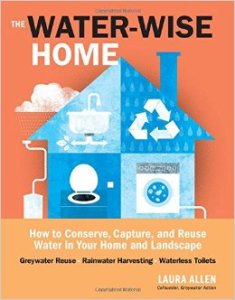Can you guess America’s largest irrigated, non-food producing crop?? Hint: It covers 63,000 square miles, according to NASA satellite imagery. Hint hint: It swallows 19 trillion gallons per year. The answer is grass. Ordinary front-lawn grass.
Now, it may not seem like an atrocity to soak our lawns with freshwater. After all, 326 quintillion gallons are available on Earth. I suppose I should mention only 3% of all those gallons is fresh (without poisonous quantities of oceanic salt). About 2/3 of that freshwater is locked up in ice and glaciers. Of the rest freely flowing, only .007% is clean and drinkable. Oh, and did I mention that .007% must be shared among the world’s 7 billion people…and a shitload of dumb grass?!
Where did I learn all this craziness?

Allen, Laura. The Water-Wise Home: How to Conserve, Capture, and Reuse Water in Your Home and Landscape. North Adams, MA: Storey Publishing, 2015. Print.
Genre: eco-how-to
Summary: This very practical how-to guide shares useful diagrams and step-by-step instructions for DIY water projects, ranging from the simple to the complex.
Critique: Allen succinctly and startlingly explains the water shortage in her home state of California. She expands the conversation to the wider water crisis currently haunting the Southwest, and she concludes with an overview of the water catastrophe preying on the rest of the world. And that’s just the first chapter!
The liquid resources of the American West and Southwest are not enough to meet growing demands. Much of the precious supply of drinkable water is wasted in the average home. Meanwhile, clean, uncontaminated, unpolluted, drinkable water elsewhere around the world is in woefully short supply–getting shorter all the time. These facts are shocking. No, they are demoralizing! What’s to be done? All hope is lost!
Luckily, the rest of Allen’s text is devoted to uncovering cunning methods for conserving and recycling the water that gushes from our faucets or patters on the rooftop. As a scrappy DIY-er, Allen pestered Home Depot until she was able to re-plumb her showers and sinks so the gray water gets filtered and fed to the plants outside. She studied with horticulturalists and landscape architects to learn how to to build her own rain gardens–which sink rain runoff deep into currently dwindling groundwater supplies. She has worked long and hard to become an expert. She has worked with cities and towns to revamp their water usage. She will work with you, too!
By the time you finish this book, your entire outlook on the world and its water cycle will have altered for the better. You will look at the grass in your lawn and question why it gets more water than a child living in Africa. You will criticize all the concrete around your house as it sluices precious water down the street and storm drains rather than linger and quench your flowerbeds.
In short, you will be inspired and equipped to take action. No more apathetic moping. To Home Depot! Huzzah!
Comments